Wiped Off the "Map"
By Dan Rose, Environmental GIS Technician, City of Topeka, Kansas, and the Kansas Association of Mappers
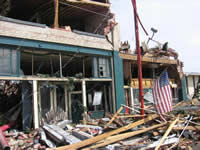 An American flag flies over the rubble created by the tornado that struck Greensburg, Kansas, on May 4, 2007. (Image courtesy of Larry Reynolds, Kansas PVD) |
Newspaper stories about the devastating tornado that swept into Kansas last May reported, "At 9:45 p.m. on Friday, May 4, 2007, the lives of the nearly 1,400 citizens of Greensburg, Kansas, were changed forever."
What the articles should have said was, "What happened on May 4, 2007, will change the lives of 2.7 million people forever." Why? Because everyone who lives in Kansas will feel the impact of the tornado that destroyed the town-today, tomorrow, and for years to come. The tornado's aftermath also proved the importance of maintaining up-to-date and easy-to-locate geographic information system (GIS) data for a modern municipality and county. After a disaster, this data's value increases significantly. Emergency responders, law enforcement, government officials, and utilities need detailed, current maps to locate possible victims, restore services, and rebuild the community.
Fortunately for Greensburg, volunteers from the Kansas Association of Mappers and other agencies statewide stepped up to the plate and, working 18 to 20 hours a day, gathered the scant data available, loaded it into a GIS, and created maps for the rescue and recovery efforts.
The Tornado Touches Down
A couple of hours before the storm hit, the National Weather Service (NWS) warned residents that they were under an unusual "tornado emergency." NWS predicted the storm's exact path: directly through the small southwestern Kansas town of Greensburg, located about 100 miles west of Wichita. Tornado sirens in Greensburg sounded 20 minutes before it actually hit.
The tornado destroyed homes throughout Kiowa County and grew into a two-mile-wide monster, with a path of destruction that stretched for 22 miles. This huge, destructive tornado was just 1 of 12 to swoop down on Kansas on May 4.
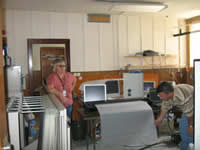 Bruce Hardesty and Vicki Baucum with the Kansas Property Valuation Department (PVD) begin to scan the 1:400-scale appraiser tax maps on Tuesday, May 8. (Image courtesy of Larry Reynolds, Kansas PVD) |
It was rated a strong EF5 tornado, with winds reaching speeds up to 205 mph. According to NWS, the tornado that hit Greensburg was the first 5 rating on the recently updated Enhanced Fujita (EF) Scale and the first 5 classification since May 3, 1999, when an F5 tornado ripped through the Oklahoma City area, killing 36 people. This series of tornadoes left 13 people dead in Kansas, 10 in Greensburg alone.
D. J. McMurry, appraiser for nearby Pratt County and a Kansas Association of Mappers (KAM) member, arrived in Greensburg 10 minutes after the tornado tore through town. Though McMurry works in Pratt, he lives just outside Greensburg on a farm, which was spared by the tornado. Although a mandatory evacuation of the town was issued shortly after the tornado touched down, he drove his skid loader to town and began clearing debris from the streets he could access. "Trees, telephone poles, and house debris covered the streets, making it virtually impossible to drive a normal vehicle through," McMurry said. He also helped families in need, working well into Saturday.
McMurry noticed that the street markers and landmark buildings were gone, confusing residents and emergency personnel from neighboring counties. He had a problem: though he has lived there his entire life, when he was traveling down Bay Street, which forms the town's western border, he himself got lost two or three times. With no buildings left, he had no sense of direction or landmarks to reference. Before the tornado, he knew where residents' homes were just by sight; he knew how to get there by knowing where to turn, not necessarily by street name. Afterward, he couldn't tell one home from the next.
So McMurry called fellow KAM member Bruce Hardesty and asked for help in what was desperately needed for emergency workers: maps.
Making Maps with Scant Data
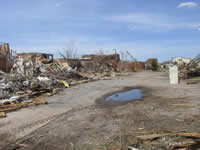 After the tornado devastated Greensburg's neighborhoods, it was easy to get lost without street signs or distinguishable landmarks to navigate by. (Image courtesy of Larry Reynolds, Kansas PVD) |
Hardesty quickly drove to his office at R&S Digital in Great Bend, Kansas, where he met with his colleague, Martin (Marty) Bieker, the company's technical services manager. Hardesty began downloading data from the Kansas Geospatial Community Commons (KGCC), aka Data Access & Support Center (DASC), in Lawrence, Kansas. KGCC is an initiative of the Kansas GIS Policy Board and DASC. KGCC is designed to be a place for state and local governments and the private sector to share and discover geospatial information and connect with the Kansas GIS community. (The KGCC/DASC Web site can be found at http://www.kansasgis.org.)
Hardesty and Bieker began transferring the TIGER street data files, Kansas Department of Transportation (KDOT) highways data, and 2006 National Agriculture Imagery Program (NAIP) 1-meter color orthophotography to Bieker's computer. There was no information, such as parcel data, specifically relevant to Kiowa County or to Greensburg itself. Hardesty was unable to obtain any additional photography other than the U.S. Geological Survey (USGS) digital orthodata quarter quadrangles (DOQQs) or NAIP photography, which are not submeter resolution. The information was then put together into a GIS. Plotting the maps took almost 25 minutes per page, so due to time restrictions, they made copies of one map to get them out to the field quickly. Those crude maps were distributed to emergency officials the night of May 5; before that, rescue crews and other volunteers were taping old maps together on the floor of the Federal Emergency Management Agency (FEMA) trailer.
The next day, they continued to create more maps-newer maps with even more data-but again still using what was available from DASC. Those maps were also printed, copied, and provided to personnel on-site.
Hardesty and McMurry knew they needed to build better maps using data and documents that might be inside the Kiowa County Courthouse, which they were finally able to enter May 8. Because the data and maps they so desperately needed were in the appraiser's office in the courthouse basement, this was a milestone in the plan to salvage data and work with it. They began hunting for any documents relevant to mapping and any other pertinent data sources. Hardesty set up a makeshift scanning area and began creating .tif images from the 1:100- and 1:400-scale Mylar tax maps hanging from a vertical file rack in the office. These maps turned out to be the only source of mapping information that was regularly updated in the Kiowa County appraiser's office and were still updated with ink and Mylar by another KAM member, Karen Butler, who worked in that office as a mapper.
From those tax map scans, R&S Digital's staff began to re-create the city of Greensburg. They split the town into northwest, northeast, southwest, and southeast quadrants to create a cadastre for the entire town. They drew in lots, blocks, parcel dimensions, and right-of-way dimensions, now in a GIS format.
But the mappers lacked information. "DASC has whatever DASC has, and we used up all the available [information] we could find from DASC," said Hardesty. "It wasn't the info [from] DASC that was the problem—Kiowa County had GIS/AutoCAD software for five years and might have been working on a GIS. It's just that nobody knew what they had or where it was located." (The Kiowa County appraiser, who worked on the county's GIS, had left his job several weeks before the tornado struck.)
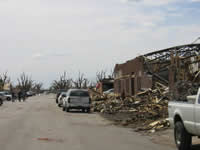 A once-prosperous downtown street in Greensburg was left with rubble and twisted trees by the EF5 tornado. (Image courtesy of Larry Reynolds, Kansas PVD) |
Hardesty and McMurry scoured the appraiser's office looking for disks: CDs, DVDs, anything with GIS data or aerial photography. McMurry found some information, including some .dwg AutoCAD files, but they were not of much use. They thought there very likely could be some aerial photography somewhere in the office, as they found one hard-copy map at 1:100-scale. Surprisingly, they discovered the county appraiser's desktop computer still intact. They sifted through the information on the computer, looking for any GIS, any aerial photography, anything of use. They found a computer folder marked "GIS" and started making a map using data that was in that folder; again, merely bits and pieces of assorted data that looked as if a project had been started but never completed.
While looking through the salvaged computer, Hardesty and Bieker noticed something loose inside the computer's cabinet. Once they opened it, they discovered an additional hard drive that had somehow become disconnected from the rest of the computer. Contained on that hard drive was year 2000 aerial photography!
They were ecstatic; by this time, they had both been working nonstop, 18- to 20-hour days, and had finally seen a spark of light at the end of a seemingly never-ending tunnel. They immediately downloaded the data; the photos were at a standard 1"=833' aerial photo scale and had a 6" pixel resolution. They weren't sure of the photo control and could not find any supporting metadata, but they had finally found quality aerial photographs. They could finally do "real mapping" and create maps that would meet National Map Accuracy Standards (NMAS) of 1"=100'.
"That was a godsend," Hardesty said. "Without it, we would have been forced to map to the 2002 DOQQs 4." Hardesty brought the newly found images back to his office in Great Bend. Staff inserted the images, orthorectified them, created MrSID files, and eventually created a mosaic of the areas around Greensburg. There were some gaps left by the orthorectifying process, but the images were far better than anything else they had available from DASC or any other source.
On May 9, Hardesty brought a multitude of plotted maps back with him to Greensburg that Bieker had created—maps that could actually be used in the field without having to tape them together. Hardesty and McMurry spent part of the morning handing out their maps to the search and rescue crews, FEMA, and other organizations.
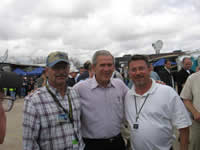 President George Bush visited Greensburg on Wednesday, May 9, 2007, and took time for a photo with two KAM members, D. J. McMurry (left) and Bruce Hardesty (right). McMurry and Hardesty were both instrumental in creating GIS maps after the tornado. (Image courtesy of Larry Reynolds, Kansas PVD) |
Bieker then contacted Kansas Gas Services (KGS) in Topeka, requesting any data related to their customers in Greensburg. Bieker said that when KGS first responded, they were hesitant to provide the data. That is, until he told them in very simple terms, "Look, this is for Greensburg, guys." An e-mail containing the KGS natural gas main and customer point data was received within minutes.
"In an emergency situation you have to have this kind of reciprocation from everyone involved," observed Hardesty. "Without their data, we wouldn't have had addresses for the buildings-no way to make a logical kind of map that could be used on the ground. We just needed to get in contact with the right person!"
Bring the Data Together
The question remains: Will the problems that the KAM members encountered during the Greensburg mapping situation provide a much-needed drive for other counties to get "on the ball"?
"There needs to be a push to get all local GIS data in the state of Kansas to DASC," Hardesty said. "A lot of counties have the 'I paid for this, it's mine' mind-set. A lot of counties say, 'We have a GIS,' when they really don't have a working GIS. Then there are the ones that do have a viable GIS, and they're just reluctant to give out what they do have."
Hardesty continued: "If you're going to have a GIS in a county, somebody needs to be able to show more than just a pretty map on the wall. County officials aren't technical enough to know the difference between having people that work for them with the GIS software and having an actual working GIS. The way they see it, as long as a map can be produced, they have a GIS. What you can pull from DASC right now for Kiowa County just isn't enough to produce something that is needed in the time of emergency. We proved that DASC needs more local county data."
"I want everybody to understand that 'storing off-site' doesn't mean storing over at the local bank; you need to be storing in another county," said McMurry. "But if you don't have any data, it wasn't there in the first place. And if you do back up your data, putting that backup CD down at the local bank obviously won't do any good if the bank is blown away too." "Every document needs to be scanned, put on some kind of media, and stored somewhere," said Hardesty. "It's a must, because how [the courthouse] stood is amazing, with most of its contents intact inside."
Some counties rely on companies such as R&S to create and maintain their parcel base or put their data on a Web portal using Esri's ArcIMS, charging a maintenance fee. The problem may lie with the lack of education of the "higher-ups", thinking that aerials are updated all the time or that a county's parcel base is constantly updated when that may not be so.
Propaganda regarding the idea that "anybody can make a map" and the wide use of mapping Web sites furthers that misinformation. Most counties in Kansas have free or low-cost software at their disposal, but may not have the means to train their personnel on how to use it, and that can lead to discouragement. They may have the tools but sometimes do not have the knowledge to put those tools to good use.
Discussion has already begun in Kansas related to creating a type of mobile mapping center that can quickly respond in the event of an emergency such as the one in Greensburg. "I just don't understand why there isn't more reciprocation between our counties, our cities, and DASC," concluded McMurry. "Cities might say they're mapped, but what does 'mapped' mean? Does that mean that you have Mylar tax maps hanging in an office, or does that mean you actually have a working [and up-to-date] GIS? You know, you can store your data on DASC; they won't give it out unless you want them to. That's why DASC is there. And if there would have been Kiowa County data, it would have been available almost immediately for us to use."
Dan Rose can be contacted at drose@topeka.org or gps_for_usgs@yahoo.com. Bruce Hardesty can be contacted at bhardesty@rsdigital.com.
D. J. McMurry can be contacted at dj@prattcounty.org.